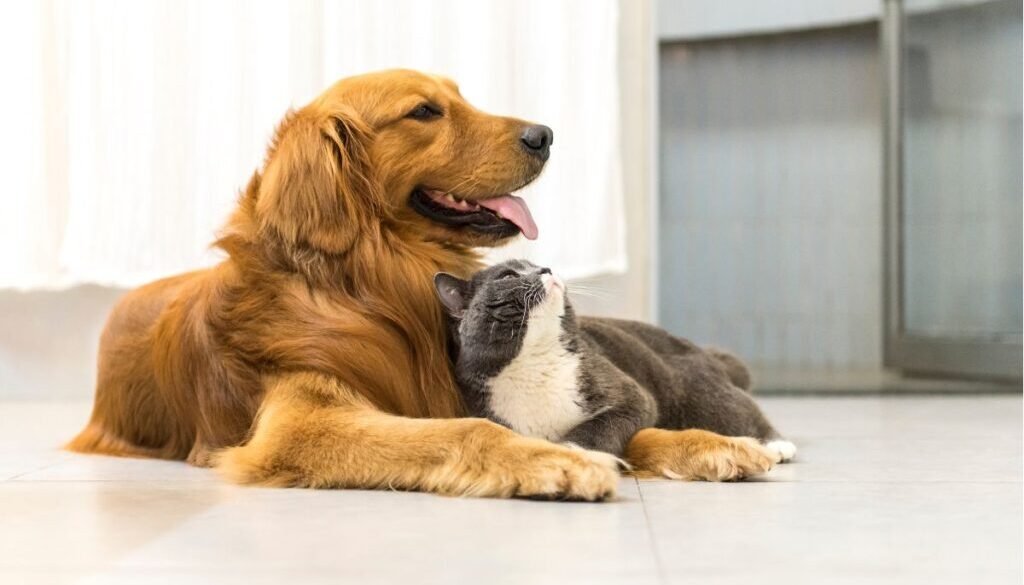Are Golden Retrievers Good With Cats? A Guide to Furry Friendship
Can Cats and Dogs Really Be Friends?
Have you ever heard the phrase “fighting like cats and dogs”? It paints a dramatic picture, but is it always true? Many pet lovers dream of a home where their dog and cat coexist peacefully—or better yet, become best buddies. If you’re considering adding a golden retriever to your household (or introducing one to a cat), you might be wondering: Can this famously friendly breed actually get along with cats?
Here’s the good news: Golden retrievers and cats can make fantastic companions—if the introduction is done right. In this article, we’ll explore why golden retrievers are well-suited for living with cats, how to navigate the introduction process, and tips for overcoming potential hiccups. By the end, you’ll have all the tools to create your own adorable pet duo.
What Makes Golden Retrievers Special?

Golden retrievers are one of America’s most beloved dog breeds, consistently ranking in the top three most popular dogs according to the American Kennel Club (AKC). Known for their sunny dispositions, they are often described as the “sweethearts” of the dog world. But what is it about golden retrievers that makes them such a great match for households with cats?
- Friendly and Gentle Nature
Golden retrievers are famously friendly—not just with humans but also with other animals. With their calm and non-aggressive temperament, golden retrievers are less likely to provoke territorial cats.
- Playfulness Without Aggression
While goldens love to play, their energy is rarely intimidating. They’re not known for aggressive chasing, which is often the trigger for a dog-cat feud. Instead, they have a knack for making interactions fun.
- Trainability
Golden retrievers are highly trainable and eager to please their owners. This makes it easier to teach them commands like “leave it” or “stay,” which can be invaluable when managing their behavior around a cat.
- Emotional Intelligence
Goldens are incredibly intuitive and sensitive. They can often “read the room,” making them more likely to pick up on a cat’s body language and adjust their behavior accordingly.
Did you know that golden retrievers were originally bred as hunting companions but are now equally famous for their work as therapy dogs? Their adaptable and kind-hearted nature makes them a natural fit for multi-pet households
The Feline Perspective: Understanding Cat Behavior

To help golden retrievers and cats coexist, it’s crucial to consider the cat’s point of view. While dogs often seek companionship, cats are more independent and territorial. By understanding what makes cats tick, you can better manage their relationship with a golden retriever.
Key Cat Traits to Keep in Mind:
- Territorial Nature: Cats may see a new dog as an intruder. A sudden change in their environment can make them anxious or defensive.
- Body Language is Key: Cats use subtle signals—like flicking their tail or flattening their ears—to communicate how they’re feeling. Recognizing these cues can help you intervene before conflicts escalate.
- Hierarchy Matters: Cats like to establish their place in the household hierarchy. Providing them with high spaces like cat trees can help them feel secure when a dog is around.
Why Golden Retrievers and Cats Can Get Along

Key Traits of Golden Retrievers
Golden retrievers bring several characteristics to the table that make them one of the most cat-friendly dog breeds:
- Patience: Goldens are rarely pushy. They can give a cat the time and space it needs to warm up.
- Sociability: Golden retrievers often see potential friends in everyone, including cats.
- Gentle Play Style: Unlike some high-energy breeds, goldens have a naturally soft mouth and gentle movements that won’t scare a cautious cat.
Tips for a Smooth Introduction
Making a good first impression is essential. Follow these steps to ensure a peaceful introduction between your golden retriever and cat:
- Prepare a Neutral Zone
Before introducing your pets, create a safe, neutral space. Let them explore the new scents of each other without direct contact. For instance:
- Start by using baby gates or barriers to separate the pets for about 7–10 days. During this time, allow them to see and smell each other from a safe distance. Once they appear calm and curious around each other, begin short, supervised interactions in a neutral space. Gradually increase the duration of these sessions over 1–2 weeks, always monitoring their behavior.
- Swap blankets or toys between your golden retriever and cat so they can get familiar with each other’s scent. This helps each pet associate the other with something safe and familiar, easing the transition into shared spaces.
- Supervise Initial Meetings
Never leave a golden retriever and a cat alone during their first interactions. Keep the dog on a leash and monitor their body language. Reward both animals with treats for calm behavior.
- Give the Cat Escape Options
Providing access to higher ground, like shelves or cat trees, helps cats feel secure during interactions.
- Keep Sessions Short and Positive
Gradual introductions work best. Short, positive sessions help build trust over time, preventing either pet from becoming overwhelmed.
Potential Challenges and How to Overcome Them
While golden retrievers are naturally friendly, challenges can arise when introducing them to a cat. Here’s how to address common issues:
Challenge 1: Chasing Behavior
Golden retrievers may instinctively chase a running cat, mistaking it for play. To prevent this:
- Teach your golden the “stay” or “leave it” command early.
- Provide the dog with plenty of exercise to reduce excess energy.
Challenge 2: Territorial Cats
A cat may hiss, swat, or hide when it feels its territory is threatened. Help your cat feel secure by:
- Maintaining its usual routines, such as feeding and playtimes.
- Giving it dedicated “safe spaces” where the dog isn’t allowed.
Challenge 3: Overenthusiastic Dog
Some golden retrievers might overwhelm a cat with their size or eagerness. To manage this:
- Use a leash to control interactions.
- Encourage calm behavior by rewarding the dog for being gentle.
How to Help Your Pets Bond
Building a strong relationship between your golden retriever and cat takes time, patience, and consistency. Here are additional tips to foster a positive bond:
- Share Positive Experiences
Engage both pets in shared activities like sitting together during family movie time or enjoying treats in each other’s presence.
- Respect Individual Personalities
Not every dog and cat will become best friends—and that’s okay. Respect their boundaries and let their relationship develop naturally.
- Use Pheromone Products
Products like Feliway for cats, which mimic calming pheromones, or calming diffusers for dogs, designed to reduce anxiety, can help create a more peaceful home environment. These tools are particularly useful during the initial stages of introducing your pets.
FAQs About Golden Retrievers and Cats
Q1: Are golden retrievers naturally good with cats?
Yes, golden retrievers are known for their friendly and gentle nature, making them one of the most cat-friendly dog breeds.
Q2: What if my cat hates dogs?
If your cat has had bad experiences with dogs, patience is key. Gradual introductions and positive reinforcement can help build trust over time.
Q3: Can a golden retriever live with a kitten?
Yes, but supervision is crucial. Golden retrievers are usually gentle with smaller animals, but kittens are fragile and require extra protection during interactions.
Q4: How long does it take for a golden retriever and cat to get along?
Each pet pairing is unique—while some bond within days, others may need weeks or months to feel comfortable. Consistency and patience are essential.
Final Thoughts
Golden retrievers are a wonderful choice for families with cats. Their friendly, adaptable, and patient personalities make them more likely to coexist peacefully with feline friends. With careful planning, gradual introductions, and lots of positive reinforcement, you can create a harmonious multi-pet household.
At the end of the day, the key is understanding and respecting the unique needs of both pets. If you’re willing to invest time and effort, you might just end up with the cutest interspecies friendship—and a home filled with double the love and laughter.
Are you excited to foster a golden friendship between your retriever and cat? Start with patience, stay consistent, and celebrate every small success—because every pawstep brings you closer to harmony!



